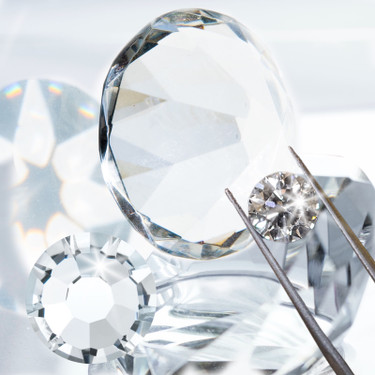Rhinestones vs. Diamonds: What Are the Differences?
Posted by Rhinestones Unlimited on Dec 16th 2022
It's a common misconception that diamonds and rhinestones are similar in their material and how they are made. Rhinestones might have the same appealing luster and shine as diamonds, but there are quite a few differences in their compositions and uses. If you're curious about the differences between rhinestones and diamonds, we have everything you need to know below!
To simplify the question, diamonds can cut glass and rhinestones are made of glass or a high quality glass called crystal. Diamonds score a 10 (the highest) on the Moh's scale of hardness, while glass is a 6 – 7 on the same scale. Crystal is essentially glass with traditionally a higher lead content thus making crystal a much harder material on the same scale. Crystal is used to create ultra thin wine glasses that are actually stronger than a much thicker and lower quality wine glass made of glass.
What Are Diamonds?
Diamonds are naturally occurring minerals comprised of pure carbon. They form when carbon deposits deep in the Earth's upper mantle are subjected to extremely high temperatures and pressures. This crystallizes the carbon, transforming it into the hard, glassy gems we know and love.
What Are Rhinestones?
Rhinestones, on the other hand, are man-made. Originally, the term rhinestone referred to gems cut from rock crystal collected from the Rhine River in Central Europe. Get it? They're stones from the Rhine: rhinestones. But today, the term refers to a diamond imitation made of crystal or lower quality glass with different levels of precision machine cut faceting or the lowest quality molded faceting with no machine cuts. All of the rhinestones from Rhinestones Unlimited are made from a high quality glass referred to as crystal. Other lower quality rhinestones are made from lower quality glass, plastic and many times do not have precision cut facets or a high degree of quality controls in their manufacturing process. Rhinestones, much like artful glass made in the Bohemian region of the Czech Republic, come in an array of colors, unlike pure diamonds, which are only clear.
So What's the Difference?
There are several differences between rhinestones and diamonds. Mainly, as already mentioned, diamonds are natural, while rhinestones are man-made. Diamonds are made from pure carbon, while rhinestones come in a variety of materials—some natural such as glass and crystal, and some synthetic such as plastic and acrylic. Diamonds, when structurally perfect, bear no color. Rhinestones, on the other hand, are available in a rainbow of hues. And of course, real diamonds will cost you an arm and a leg, but rhinestones are very affordable. Rhinestones were referred to as "A diamond for every woman" by rhinestone cutting specialist and founder of Swarovski, Daniel Swarovski. We all deserve to sparkle!
Do you want to embellish dance costumes, show wear and tack, or even just your everyday fits with the look of encrusting them in real diamonds? Give imitation diamonds (a.k.a. Rhinestones) a try instead. At Rhinestones Unlimited, you'll find a treasure trove of crystal flatback rhinestones from brands such as LUX Austrian Crystal® and MAXIMA Crystals by Preciosa®. Our crystal rhinestones are the most glamorous of all and glimmer alluringly under the light. They'll make the perfect embellishment for your outfit!

 Bulk
Bulk Crystal
Crystal Crystals
Crystals  Sales &
Sales &